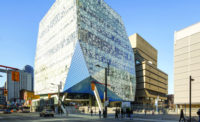Toronto, Canada
The industrial yellow-brick building one block north of Toronto’s Dundas Square in the heart of the city has been home to the Ryerson University School of Image Arts since the late 1960s. But it was no match for the school’s growing reputation in photography, film, and digital media. The former brewery warehouse and bottling plant, built in 1953, was windowless, cramped, and technologically out of date. It also lacked good exhibition spaces. But the recent gift of one of the most significant compendiums of 20th-century photojournalism—the Black Star Collection—motivated the university to transform the serviceable building into a dynamic media center that radiates with the energy of the activity and contents within it.
Given by an anonymous donor, the nearly 290,000 black-and-white photographs, amassed by the New York'based Black Star agency between 1910 and 1992, came with $7 million in seed money. Initially, university officials wanted to modify the existing structure to accommodate conservation-standard storage, curatorial spaces, and a rooftop gallery for the collection, which would be managed as a separate entity from the school program. But according to architect Donald Schmitt, as the administrators reviewed the options it became clear that the time was right for a more extensive overhaul.
“On the one hand, they needed to have total darkness and cool temperatures to preserve the delicate artifacts,” says Schmitt, design principal at Diamond Schmitt Architects (DSA). “On the other hand, photography is about light. So we explored the potential for establishing a luminous presence in the city, one that could be understood as a place for viewing artwork made with light.”
Stretching the limits of the tight urban site, the architects organized the building to create distinct yet linked entrances and domains for the School of Image Arts and the newly created Ryerson Image Centre (RIC), which will manage the collection. They added seismic reinforcement, IT infrastructure, and a state-of-the-art HVAC system, then extended the building out as much as 16½ feet around three sides, opening the lower floors with fritted glazing to bring sunlight into public areas, faculty offices, and student lounges. This added layer of transparency also provides welcoming views into the once impenetrable facility, inviting the public to enter through a glass portico and visit the RIC or one of the student galleries DSA tucked into the ground floor. Large translucent photo images, printed on vinyl, along the window bank above this long entry foyer serve as a subtle “sign” and an outdoor extension of the works on display.
A vibrant LED double-skin facade wraps the remainder of the old brick, luring passersby after sundown with a colorfully curated digital display. Developed by DSA together with Consullux Lighting, the curtain wall is made of removable 3-by-8-foot panels of white laminated glass held by an aluminum support system. To prevent shadows and hot spots, the cross-framing at the base of each panel is bordered with a strip of individual, addressable DMX-controlled RGB LEDs that reflect off the existing reclad building envelope, which has been insulated and coated with white stucco.
The designers wanted the lighting to be intelligent and as future-proof as possible, so the system is Ethernet-capable, explains lighting designer Ion Luh. But neither she nor the architects realized the implications of its potential until the building’s creative occupants got involved. Intrigued by the protocol, new-media faculty member David Bouchard, along with students and artist-in-residence David Rokeby, took it upon themselves to create an interactive smart-phone application, accessible and free to the public via the Internet. So anyone can use a touch screen to draw sweeping lines around the walls that mingle with other emerging artworks to form a spirited communal mural—in a range of over 13 million possible color combinations.
“It’s fantastic,” says Schmitt. “The university controls the gate, but when it’s open there are at least 50 students, or whoever, around the building playing with the surface.”
The Black Star Collection and the new-media wall attracted over 67,000 visitors when the RIC opened during Toronto’s 2012 Nuit Blanche, an all-night arts festival in September. It continues to draw 200 or more museumgoers a day, plus plenty of students gravitating to the playful skin and daylit lounges. Renewed and illuminated, the quiet institution has become a lively destination generated by the power of light.
People
Formal name of building:
Location:
Completion Date:
Gross square footage:
Owner:
Architect:
Personnel in architect's firm who should receive special credit:
Architect of record:
Interior designer:
Engineer(s):
Consultant(s):
General contractor:
Photographer(s):
CAD system, project management, or other software used: |
Products
Structural system:
Exterior cladding:
Roofing:
Windows:
Doors
Hardware
Interior finishes
Furnishings
Lighting
Conveyance
Energy
Add any additional building components or special equipment that made a significant contribution to this project: |











Post a comment to this article
Report Abusive Comment